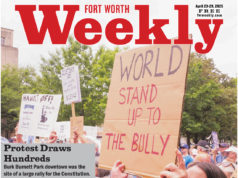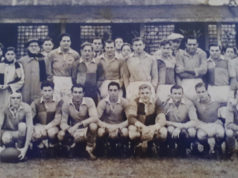The idea of realigning Harley Avenue near the Will Rogers Memorial Center to provide better access to a future new rodeo arena has been around for a while. But in the last few weeks, despite questions about whether it might create more problems than it solves, a new version of the $3 million project has moved high on Fort Worth’s wish list of road improvements — a list that’s almost as congested these days as local freeways and feeder roads.
“The city hasn’t met with businesses nearby, and they are pushing this through without any data,” said Early Davis, vice president of the Association of Businesses of the Cultural District. “It seems like everything is being kept secret.”
 Neighborhood leaders might be forgiven for thinking that the association of the name Bass with the project might have something to do with the rush job. Event Facilities Fort Worth Inc., a private nonprofit organization led by billionaire Ed Bass, is pushing for the new arena for rodeo and cutting horse events and has purchased nearly $7 million in property in the area in recent years, including prime properties near the intersection where the re-aligned road would intersect with Montgomery Street.
Neighborhood leaders might be forgiven for thinking that the association of the name Bass with the project might have something to do with the rush job. Event Facilities Fort Worth Inc., a private nonprofit organization led by billionaire Ed Bass, is pushing for the new arena for rodeo and cutting horse events and has purchased nearly $7 million in property in the area in recent years, including prime properties near the intersection where the re-aligned road would intersect with Montgomery Street.
Harley runs between University Drive and Montgomery, just north of the Fort Worth Botanic Gardens. Originally, the re-alignment would have moved the intersection south to about where Byers Street comes in. The new plan pushes it even farther south, to El Campo Avenue, several blocks closer to the congested I-30 interchange.
The Harley realignment was included in the projects for which voters approved a $273.5 million bond issue in 2004. In the last six years, the city has used only about half of that bond authority because of concerns over the city’s weakened bond rating, decreased state and federal funding, and a tax base affected by the country’s economic crisis. As a result, the city staff has had to pick and choose among road projects, to decide which ones can wait longer.
In the case of the Harley Avenue project, the arena that it would theoretically serve has not yet been approved by voters in a bond election, and that approval is not likely to be sought before 2013. But city staffers told the Fort Worth Plan Commission a few weeks ago that the project needs to be done in 2011, to ease traffic congestion on Harley, improve parking access, and to encourage economic development.
Those concerns seemed strange to local residents and business leaders. Plan commission member Jim Weitholder, who lives in the area, acknowledged that traffic on Harley is not an issue. “Harley is not a busy street as it is aligned now,” he said.
Other critics point out that, if traffic is an issue, the city staff should have done studies before now to see whether the new proposed alignment will help traffic flow or perhaps even hurt it.
Dana King, president of the Arlington Heights Neighborhood Association, said traffic congestion in the area where the staff wants to redirect Harley is already fairly common. “There could be a pretty big backup if they do this street as it is designed,” she said. “I would just hope they could do a [traffic] study to let the residents and business owners know what the effect would be.
Another Plan Commission member, architect Bob Kelly, questioned the alleged economic development benefit. “I don’t see how this alignment helps any development,” he said.
The plan for Harley “makes no sense,” said one local real estate developer with interests in Cultural District, who asked that his name not be used. “If the rodeo arena is approved by voters, then there is still plenty of time to build this road while the arena is being constructed. But there are so many transportation projects in this city that need to be funded, and how this got to up high on the list is sort of outrageous.”
As for parking, the city built a $30 million, seven-level parking garage last year, and even on busy Saturdays at the WRMC, the top four levels are usually empty.
Despite those concerns, the commission went along with city staff recommendations and voted unanimously to make the new alignment part of the city’s master thoroughfare plan.
“We didn’t approve the construction plans, we just merely recommended it to council,” Weitholder said. “Council would have to vote on whether to do this. And we asked the city staff to do a traffic study before putting it before council.”
The whole re-alignment project, including new water and sewer lines, will cost about $16 million. The council approved an earlier version of the plan in July. Because of the proposed new alignment, the plan must go back before the council.
If local business and neighborhood leaders are critical of the Harley Avenue plan, it’s not because they object to all changes along Montgomery Street. Davis said that, with the expansion of the University of North Texas Health Science Center and the opening of the new Fort Worth Museum of Science and History, Montgomery is fast becoming the entryway to the Cultural District.
“Obviously, this project is being done on behalf of the rodeo arena, but there will be others affected, and we don’t know what the unintended consequences might be 10 years down the road,” he said.
Bryan Beck, senior capital projects officer for the city, told the Weekly in an e-mail that the terminus of the road at El Campo has to do with development potential. “The El Campo alignment provides better access to undeveloped property in the area,” he said. Beck also said the Harley realignment would be “one of the last arterials to be constructed” from projects that were approved in the 2004 bond program.
Event Facilities, the group whose undeveloped property looks to benefit the most from the realignment, lists its mission as promoting agricultural sciences and “to assist with the establishment of a new arena for the Will Rogers Memorial Center.” According to its 2009 IRS filing, Events Facilities had $50 million in assets. Neither the group’s board chairman, Ed Bass, nor CEO Mike Groomer would comment for this story.
City staffers have estimated that Fort Worth needs to spend $1.8 billion over the next decade to keep up with transportation demands. That includes $585 million to remedy “existing street capacity deficiencies” and $400 million to replace poor-quality neighborhood streets.
Even though the city is counting on using bond capacity approved in 2004 for the Harley project, the city is not actually planning to sell those bonds until 2013 — two years after the project is started. Why? Because the city’s bond rating, which is still recovering from a drop in 2004, could be affected.
In the meantime, the plan is for the city to lend itself $1.75 million from another pocket to fund the project. That pocket is the city’s aviation fund, which has grown fat with profits from Barnett Shale gas drilling at city airports. By federal law that money must be used only at those airports — but the city is availing itself of a loophole that allows it to lend the money for other projects, as long as the funds are repaid with interest. The loan would be for three years, with interest totaling about $230,000, according to city estimates.
“The city has moved this project up and is paying a higher cost to do that,” the real estate developer said. “But no one can answer the question as to why it needs to be done now.”











